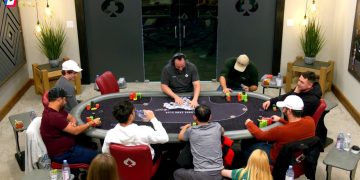If you like playing poker tournaments, you’re going to fall in love with 6-Max Poker. In recent times, 6-Max Poker tournaments have been growing in popularity. These poker games originally grew in popularity online, but one day someone decided to try them out as live Texas Hold’em poker tournaments.
That was a very good idea because poker players love them. I know this firsthand because I have played in several of them on the WSOP Circuit. They usually run on the first Monday after the Re-Entry weekend, which is always the first of two weekends of a Circuit stop.
The WSOP Circuit isn’t the only place you can find 6-max poker events, but it’s the only experience I have with them in a live setting. Therefore, I will tell you what I know based on those experiences.
The first thing I should tell you is that one of the greatest appeals to these short-handed Texas Hold’em poker tournaments is having more elbow room.
You have to understand that most of the time, we’re playing full-ring games, and unless it’s a high buy-in, those full-ring games are 10 players. We’re basically packed in like sardines.
It’s always a huge relief when you get deep enough in a tournament that they switch to 9-handed, but it’s still relatively tight quarters. When you play 6-max poker, you have all the room in the world. It’s one of the most relaxing poker experiences you will ever have. That is, unless, you end up at a tough table.
I’ll go over some basic Texas Hold’em strategy for 6-max poker tourneys in a minute, but prior to getting to that, the final sentence in the paragraph above should tell you a lot. Yes, the one that mentions the tough table.
You have two choices. You can either approach your table wondering if it will be a tough table or you can be the one to make it a tough table. I would highly recommend the latter. Since many people reading this information are new to the game, I will do my best to keep this to basic Texas Hold’em strategy.
The Most Important Point for 6-Max Poker

I’m going to go over a lot of poker strategy for 6-max poker, and some of it will not follow the traditional poker rules for winning, but there is one concept that all winning poker players should understand about 6-max tournaments: Your opponents usually don’t have a good hand!
Do you have any idea how important that is? It relates to you making it a tough table when you arrive. This is a mental decision you must make prior to sitting down. After one hour in 6-max poker, your opponents will peg you as one of the following: a Nit, a calling station, a TAG player (tight aggressive), or a scary player.
In full-ring poker games, you want to be a TAG player. In a 6-max poker game, you want to be the scary player. Do you want to be seen as the person who sits around and waits for a hand, or do you want to be seen as the player who attacks relentlessly and takes complete control of the table?
There is a twist though. A lot of people can be the player who attacks relentlessly and takes complete control of the table, but not many people can do it with finesse. In other words, you want to be the aggressor, but you also need to know when to fold. You must practice discipline.
When your opponent has a good hand, they will let you know. They’re not going to say it verbally or send you an obvious tell, but they will tell you with their betting patterns. This is basic Texas Hold’em strategy, but only poker players who can eliminate Ego are capable of pulling it off.
6-Max Poker: Collecting Information on Your Enemies
There is an often overlooked advantage to reading opponents in 6-max poker games. Since there are only five opponents to read, you can pick up on their patterns much easier than you can pick up everyone’s patterns in full-ring poker tournaments.
In a 6-max poker game, you can watch one player at a time for about an hour and really pick up on what they do. You will learn all their betting patterns, and you will pick up some physical tells. In regards to physical tells, you don’t need to pick up on them consciously. A lot of the time these reads will be subconscious, but they will help because when you’re in a tough spot, your gut will tell you exactly what to do. It’s not against the poker rules to study one opponent for an hour, yet very few people do it.
When you watch one player play their poker hands for an entire hour, you’re going to be inside their mind. After one hour, move to the next player at the table and do the same thing. This will take five hours, but most poker tournaments take around 10-14 hours for a Day 1 in a poker tournament.
You will have plenty of time to pick up information. And you want to pick up that information when the blinds are lower because you want to apply it when the blinds are higher and the pots are bigger.
Think of being in a war. You’re collecting as much information on your enemies as possible prior to forming a plan of attack. Do you think other players are thinking this way? Not a chance. If you’re the one collecting the most information on your enemies, then you’re going to have a distinct advantage over them. This isn’t basic Texas Hold’em strategy, but it’s not complicated either.
6-Max Poker: Speed of Play

You’re obviously going to play more poker hands in a 6-max poker tournament. That’s basic Texas Hold’em strategy for any short-handed game. You want to widen your range, but the best way to protect the weaker hands is by raising. Remember: Your opponents usually don’t have a good hand!
By raising with a wider range of hands, you’re going to steal a lot of blinds. This is important because you must stay ahead of the blinds. In a 6-max poker game, the blinds are going to be hitting you more often. Therefore, you must play more poker hands to stay ahead of them. When you put in your pre-flop raise, remember that your opponent can’t see what you have. They will usually give you respect for a strong hand, but not always.
Here’s the key to this situation. A lot of players fear raising pre-flop because they don’t want to be three-bet. They feel like they will be wasting chips. But in a 6-max game, you’re going to win a lot more than you lose by raising pre-flop. You should have absolutely no fear of raising pre-flop with marginal hands because you will usually get folds.
If you don’t get folds, you will get calls, which means you could hit the flop. If you don’t hit the flop, you should almost always c-bet because your opponents are also playing a wider range. You will be raised once in a while. When that happens, fold unless you’re holding strength. And if you’re in a good poker position, call. If you hit that flop, it could pay off in a huge way in a 6-max poker game.
Your opponent is also thinking to consistently apply pressure, but the difference between him and you is that he’s going to barrel two or three streets. If we see resistance when raising, we’re going to back off after the flop. Most people will keep firing in a 6-max. Therefore, while slow-playing can be dangerous, it has the potential to pay off big here.
If we hit the flop hard and call (not raise), our opponent is going to keep coming after us because that’s the mentality in a 6-max. If we feel good about our hand on the river, we need to find the perfect bet, as in the maximum amount we can bet without our opponent folding. A 6-max poker game might be a game of aggression, but you must also throw in some deception.
This is more advanced than basic Texas Hold’em strategy, but only in a psychological sense. There are not mathematical formulas to figure out.
Big Blind Defense

Defending your big blind in a 6-max is a basic Texas Hold’em strategy. You want to defend your big blind a lot more often in 6-max poker tournaments. Your opponents also know that they need to stay ahead of the blinds, so they’re going to be trying to steal your big blind. You need to let them know that if they knock on that door, there’s a beast inside.
Three-bet with any marginal to strong hand. It will usually work, but even if it doesn’t, you’re sending a strong message. Once again, do this early in the tournament so it’s not expensive. You’re basically sending a warning not to be messed with so it will slow down your opponents when the game is more important.
This is long-term basic Texas Hold’em strategy, and it can be highly effective. The only time it’s not effective is when you have players at your table who don’t pay attention and aren’t playing any kind of basic Texas Hold’em strategy.
Calling Down
This is one the toughest aspects of 6-max poker game. It’s also what is likely to be the biggest factor in whether or not you win or lose. You’re going to be faced with some very difficult decisions late in the tournament. Should you call or fold?
As you know by now, I always lean toward folding if you’re not sure, but there are times when you can make a great call because of a read. That’s why the section above about studying each opponent for one hour is so important. If you do that, you will have a much better chance of making the correct decision. One of your opponents might go all-in on the turn with air whereas another opponent would only go all-in on the turn with the nuts. You need to know your opponents.
The basic Texas Hold’em strategy in 6-max is to have a wider range on call downs. I get that, and it makes sense, but only in a vacuum. The real key to success here is knowing how each opponent will approach each situation. But there is another huge factor here. You have to crawl inside your opponent’s mind and understand how they view you.
Be honest with yourself. Don’t let Ego get in the way. If you have been playing like a Nit, admit that to yourself and apply it so you make the correct decision. When you have been playing like a maniac, admit that to yourself as well. If you feel like your opponent views you as a Nit and it’s a big pot, you should lean toward a call. If you feel like your opponent views you as a maniac, you should lean toward a fold. Your opponent isn’t going to try to bluff a maniac.
6-Max Poker: Basic Starting Hands
The following information on poker strategy for 6-max starting hands should be taken with a grain of salt. A lot will depend on your table draw, and you want to focus on playing your opponents, not your cards. However, this doesn’t mean you should be opening with T2-off. That’s a bad idea. Therefore, you should at least have some idea on what poker hands to open with.
Here’s the simple version: All pairs, Ax-suited, AK-off-A8-off, KQ-suited-K8-suited, KQ-off-KT-off, QJ-suited-Q9-suited, QJ-off, JT-suited, JT-off. I would also highly recommend throwing in some out-of-nowhere opens as well: 97-off, 65-suited, K4-suited.
Basically, hands that at least have some potential in case you get called. Don’t fear raising with them. Most of the time, you will take it down pre-flop or with a c-bet on the flop. You just want the potential as a backup plan.
Final Thoughts
Since your opponents will usually not have a good hand in a 6-max game, it’s the ideal time to BE THE BEAST! Use the following poker strategy: Aggression Until Resistance. This should pay off, but you must be willing to fold/check when your opponent raises/calls. Welcome to the game, Beast! See you at the WSOP!
♠ pokerjournal.org
6-Max Poker – FAQ
What is 6-Max Poker?
This means there can only be a maximum of six players in the game. It's a very spacious atmosphere.
What starting hands should I play in 6-Max poker?
You should open up your range a little and be more aggressive in position, but don't open up your range too wide. That will get you in trouble.
How often should I defend the big blind in 6-max poker?
Almost every time. You need to let your opponents know that you don't mess around. However, if there has been a 4-bet and you have a marginal hand or weaker, it's a fold. The person 4-betting isn't targeting you.
What is the best strategy for 6-max poker?
You still want to play a TAG strategy (not LAG), but you want to play more hands than usual. You want to add some marginal hands to your opening range.

















Discussion about this post